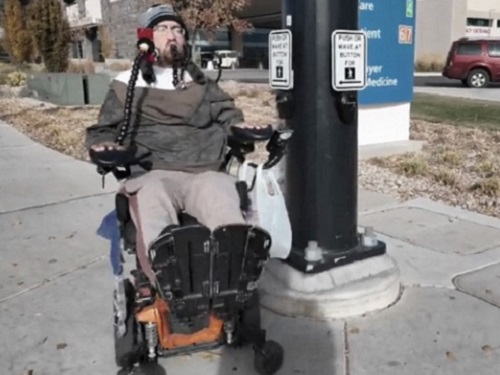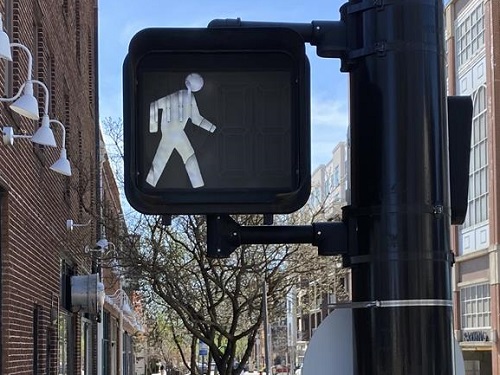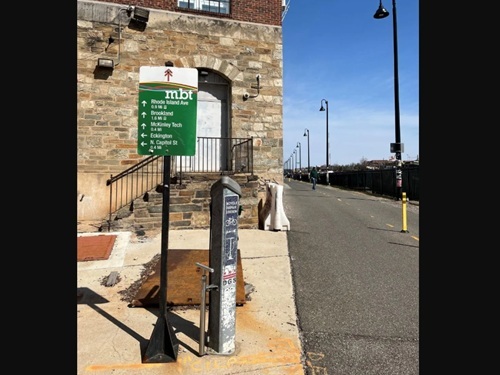To making crossing the street easier for those with disabilities, the Utah Department of Transportation is installing radar-enabled crosswalk buttons at select intersections statewide.
[Above photo via Utah DOT]
Specifically, the agency is installing “accessible pedestrian signal” or APS technology at those crosswalks. Those systems use two kinds of action – physical movement, like nodding or waving, or activation via a mobile application – to help pedestrians activate crosswalk beacons. Once triggered, the APS keeps pedestrians informed through an audio feature that includes alert statements such as “wait” and “walk sign is on.”

“This new crosswalk technology benefits everyone by facilitating safe and independent movement through pedestrian networks regardless of age or ability,” said Mike Blanchette, a Utah DOT traffic engineer, in a statement. “The app and touchless buttons are key components of an accessible, inclusive transportation system.”
Utah DOT noted that it has installed over 1,000 APS buttons at nearly 250 intersections to date, with plans to install APS technology at every signalized intersection on state routes by 2033. The agency added that APS equipment costs approximately $7,000 per intersection and that it has allocated $800,000 per year to purchase and deploy APS buttons going forward.
Currently, the agency said APS technology exists on all state-managed streets in Cedar City and Moab and is expanding to Salt Lake City, Ogden, Provo, and Logan. However, Utah DOT is encouraging the public to participate in the installation process by submitting online forms to notify the agency of the need for APS technology at a specific crosswalk.
In addition to an online map of existing and planned APS-equipped crosswalks, state residents can also use the “PedApp” mobile application to activate a button. The app also provides pedestrians with real-time supplemental information at crosswalks, such as the amount of walking time remaining or the street name and direction they’re heading. Sight-limited pedestrians can also enable a feature that helps them locate the button, Utah DOT noted.

Many other state departments of transportation are also working on ways to improve crosswalk accessibility and safety; mainly as part of broader activate transportation strategies that address pedestrian needs.
For example, in August, the North Carolina Department of Transportation adopted a new traffic signal policy that aims to boost pedestrian safety.
The new NCDOT policy states that, as new traffic signals are installed or existing ones are upgraded, they will be programmed with what is called a “leading pedestrian interval” or LPI.
That technology is designed to give pedestrians a “head start” of three to seven seconds in marked crosswalks before motorists on the parallel direction get a green light. This interval allows pedestrians to better establish themselves in the crosswalk to drivers who must yield to them before making a left or right turn.
“This change makes pedestrians more visible for drivers,” explained Nick Zinser, NCDOT’s Western Region signals engineer, in a statement. “It’s a safety enhancement, and it can be done at a low cost by reprogramming the existing equipment at our traffic signals.”

Concurrently, the Texas Department of Transportation is developing a Statewide Active Transportation Plan or SATP to gather recommendations for improving bicycling, walking, and rolling conditions across the Lone Star state.
The Kansas Department of Transportation unveiled a revised active transportation plan in May 2023 to boost walking, bicycling, safe wheelchair use, skateboarding, and non-motorized vehicle mobility options across the state.
The Oklahoma Department of Transportation also began working on its first-ever active transportation plan in 2023 – a policy toolkit the agency said can be used internally and by Oklahoma counties and towns as engineers and designers look to develop more people-friendly infrastructure.
Meanwhile, the Washington State Department of Transportation unveiled a formal Active Transportation Plan in December 2021 – a plan that subsequently won the 2022 America’s Transportation Awards contest’s “People’s Choice Award.”
 Active Transportation
Active Transportation



